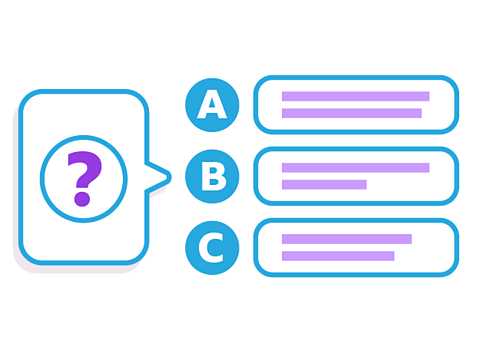Key points about regular verbs in the present tense in Spanish

Each subject pronounReplaces a noun that is the subject of the verb. has its own verb ending in Spanish.
The ending of the verb indicates who is carrying out the action.
Subject pronouns are not always needed when using verbs in Spanish.
Video - Regular verbs in the present tense
Watch this video to revise how to use verbs in the present tense in Spanish.
Learn how to use the Spanish present tense with 'ar', 'er' and 'ir' verbs
The present tense. How to talk about what you do in Spanish.
We use the present tense to talk about what we are doing now or do regularly.
In Spanish, the basic form of the verb, the infinitive, either ends in ar, er or ir.
Let’s take a verb ending in ar:
escuchar - to listen
escucho - I listen
escuchas - you listen
escucha - he/she listens
I listen to music. - Escucho mГєsica.
The great thing about Spanish is you don't need to include the word for 'I' (yo) because the end of the verb tells you who the sentence is about.
There are also verbs ending in er:
beber - to drink
bebo - I drink
bebes - you drink
bebe - he/she drinks
Mi padre bebe cafГ© todos los dГas. - My dad drinks coffee every day.
And then there are verbs ending in ir:
vivir - to live
vivo - I live
vives - you live
vive - he/she lives
ВїVives en un piso? - Do you live in a flat?
Then there are irregular verbs:
ir - to go
voy - I go
vas - you go
va - he/she goes
ВїVa al museo maГ±ana? - Is he or she going to the museum tomorrow?
Look out for whether the verbs end in ar, er or ir.
What are conjugated verbs in the present tense in Spanish?
All Spanish verbs end in either І№°щ, e°щ o°щ ir. This form of the verb is called the infinitiveForm of the verb that has not been conjugated. Usually translated with 'to' in English, eg to play..
For example:
Sorry, something went wrongCheck your connection, refresh the page and try again. - to talk
Sorry, something went wrongCheck your connection, refresh the page and try again. - to eat
Sorry, something went wrongCheck your connection, refresh the page and try again. - to live
When using verbs, you will need to be able to conjugate them. Conjugating a verb means changing the infinitive ending to match the subject pronoun (yo, іЩГє, Г©l, ella etc).
In Spanish there is a unique verb ending for each subject pronoun, so the verb ending tells you who is doing the action. For this reason, you don’t always need to use subject pronouns in Spanish.
How to conjugate regular 'ar' verbs in the present tense in Spanish
To conjugate regular verbs that end in ar, remove the ar ending from the infinitive and add the unique ending that goes with each subject pronoun to the stemThe part of the verb that is left once the infinitive ending (ar/er/ir) has been taken off. It can also be called a radical..
This is how to conjugate the verb escuchar (to listen) in Spanish:
| Subject Pronoun | Stem | Ending | Example | English |
|---|---|---|---|---|
| yo | escuch | o | (yo) escucho | I listen |
| іЩГє | escuch | as | (іЩГє) escuchas | you (informal) listen |
| Г©±ф/±р±ф±фІ№/іЬІхіЩ±р»е | escuch | a | (Г©±ф/±р±ф±фІ№/іЬІхіЩ±р»е) escucha | he/she/you (formal) listens |
| nosotros/as | escuch | amos | (nosotros/as) escuchamos | we listen |
| vosotros/as | escuch | ГЎѕ±Іх | (vosotros/as) escuchГЎѕ±Іх | you (informal) listen |
| ellos/ellas/ustedes | escuch | an | (ellos/ellas/ ustedes) escuchan | they/you (formal) listen |
For example:
Yo escucho mГєsica pop pero Г©l escucha mГєsica soul. - I listen to pop music but he listens to soul music.
Other common regular ar verbs include:
Sorry, something went wrongCheck your connection, refresh the page and try again. - to speak
Hablo espaГ±ol. - I speak Spanish.
Sorry, something went wrongCheck your connection, refresh the page and try again. - to cook
ВїCocinas para tu familia? - Do you cook for your family?
Sorry, something went wrongCheck your connection, refresh the page and try again. - to hate
MarГa odia las verduras. - MarГa hates vegetables.
Conjugating regular 'ar' verbs - Mini quiz

Translate the following sentence into English:
ВїTu madre cocina platos tГpicos?
Does your mum cook typical dishes?
The ending a is used as the pronoun is she.
How to conjugate regular 'er' verbs in the present tense in Spanish
To conjugate regular verbs that end in er, remove the er ending from the infinitive and add the unique ending that goes with each subject pronoun to the stem.
This is how to conjugate the verb comer (to eat) in Spanish:
| Subject Pronoun | Stem | Ending | Example | English |
|---|---|---|---|---|
| yo | com | o | (yo) como | I eat |
| іЩГє | com | es | (іЩГє) comes | you (informal) eat |
| Г©±ф/±р±ф±фІ№/іЬІхіЩ±р»е | com | e | (Г©±ф/±р±ф±фІ№/іЬІхіЩ±р»е) come | he/she/you (formal) eats |
| nosotros/as | com | emos | (nosotros/as) comemos | we eat |
| vosotros/as | com | Г©ѕ±Іх | (vosotros/as) comГ©ѕ±Іх | you (informal) eat |
| ellos/ellas/ustedes | com | en | (ellos/ellas/ustedes) comen | they/you (formal) eat |
For example:
Ella come cereales y іЩГє comes tostadas. - She eats cereal and you eat toast.
Other common regular er verbs include:
Sorry, something went wrongCheck your connection, refresh the page and try again. - to drink
Bebes limonada. - You drink lemonade.
Sorry, something went wrongCheck your connection, refresh the page and try again. - to read
Leo un libro. - I read a book.
Sorry, something went wrongCheck your connection, refresh the page and try again. - to see/watch
Veo la television. - I watch television.
How to conjugate regular 'ir' verbs in the present tense in Spanish
To conjugate regular verbs that end in ir, remove the ir ending from the infinitive and add the unique ending that goes with each subject pronoun to the stem.
This is how to conjugate the verb vivir (to live) in Spanish:
| Subject Pronoun | Stem | Ending | Example | English |
|---|---|---|---|---|
| yo | viv | o | (yo) vivo | I live |
| іЩГє | viv | es | (іЩГє) vives | you (informal) live |
| Г©±ф/±р±ф±фІ№/іЬІхіЩ±р»е | viv | e | (Г©l/ella/ usted) vive | he/she/you (formal) lives |
| nosotros/as | viv | imos | (nosotros/as) vivimos | we live |
| vosotros/as | viv | ГІх | (vosotros/as) vivГІх | you (informal) live |
| ellos/ellas/ustedes | viv | en | (ellos/ellas/ustedes) viven | they/you (formal) live |
For example:
Yo vivo en MГЎnchester pero іЩГє vives en Birmingham. - I live in Manchester but you live in Birmingham.
Other common regular ir verbs include:
Sorry, something went wrongCheck your connection, refresh the page and try again. - to write
Escribes un e-mail. - You write an email.
Sorry, something went wrongCheck your connection, refresh the page and try again. - to receive
Recibo un mensaje. - I receive a message.
When to use the present tense in Spanish
The present tense is used to:
say what we do regularly
say what is happening now
describe what things are like
For example:
Toco la guitarra todos los dГas. - I play the guitar every day.
Estudio inglГ©s y espaГ±ol. - I study English and Spanish.
Mi uniforme es muy feo. - My uniform is very ugly.
Video - Using the present tense
Watch this video about how to use verbs in the present tense.
An explanation of the uses of the present tense and how to conjugate it
It is my birthday. - Es mi cumpleaГ±os.
I am 15 years old. - Tengo 15 aГ±os.
When you talk about something that happens regularly or describe what something does or is doing, then you use the present tense.
The first part of the verb you need to learn is the infinitive. It’s the one you find if you look it up and translates as 'to do something'.
There are three main types of verb: ar verbs like hablar - to speak, er verbs like comer - to eat and ir verbs like vivir - to live.
When you talk about different people, the endings of the verb change.
Let’s start with ar verbs. Take bailar - to dance, the endings change like this: bailo, bailas, baila, bailamos, bailГЎѕ±Іх, bailan.
All regular verbs ending in ar follow that pattern. Like cantar - to sing and hablar - to speak.
And remember, in Spanish, you don’t need to use the pronouns words like I, you, he and she, because their endings tell you who is doing what.
He dances - baila.
They dance - bailan.
Another group of regular verbs end in er, like comer, to eat. The endings of these change like this: como, comes, come, comemos, comГ©ѕ±Іх, comen.
And the third group are the ir verbs, like compartir - to share. These become: comparto, compartes, comparte, compartimos, compartГІх, comparten.
There are of course some irregular verbs. One of the most important and useful is the verb tener - to have.
Tienes un regalo para mГ. - You have a present for me.
Tiene muchos amigos. - He/she has lots of friends.
Tienen que ir a casa. - They have to go home. And speaking of going home, another really handy one is the verb ir - to go.
I go home. - Voy a casa.
And here’s a very important irregular verb - ser, used to say 'I am'.
Soy, eres, es, somos, sois, son.
So, you're a musician? - Soy mГєsico.
Want to blame someone else for the racket? Es músico. And so on…
That's it! Party's over! Bye! Adios!
Quiz - Present tense regular verbs in Spanish
Practise what you've learned about present tense regular verbs in Spanish with this quiz.
Now you have learned about present tense regular verbs in Spanish why not explore desde hace and the present tense in Spanish?
More on Present tense verbs
Find out more by working through a topic
- count2 of 10

- count4 of 10

- count5 of 10
